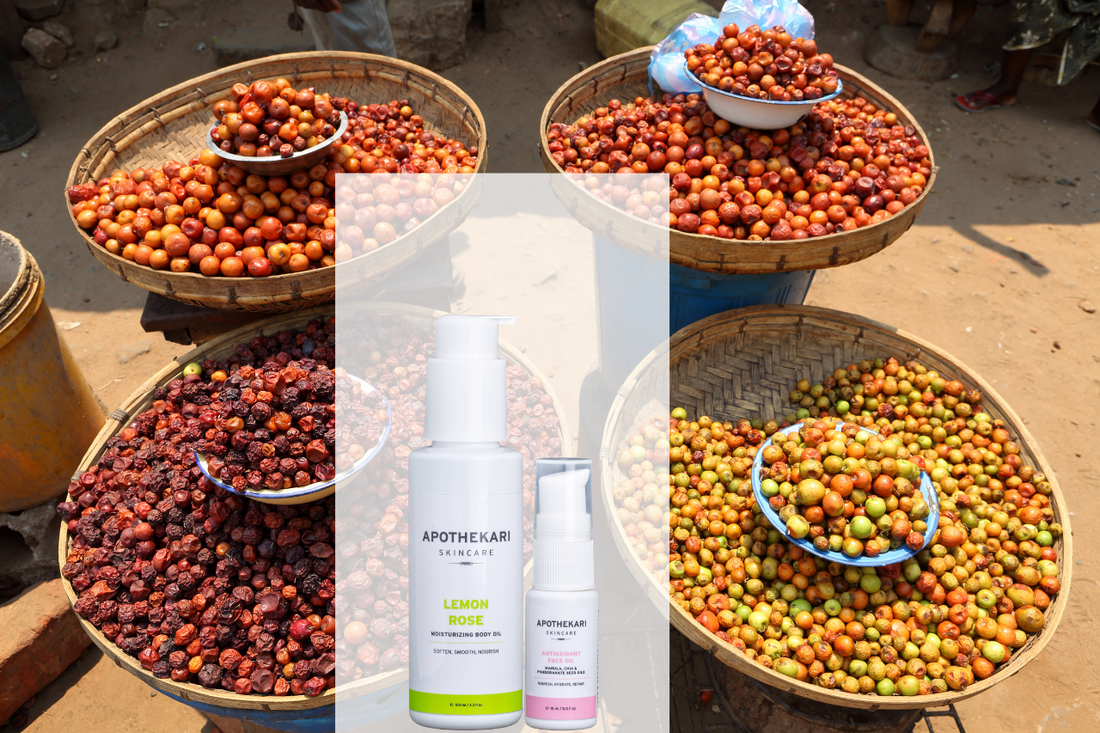Blog
Here Are the 3 Deodorant Ingredients You Should Avoid
When it comes to deodorant ingredients, some are healthier for you than others. Here are 3 that aren’t great for your skin so avoid them if you can. (Our natural deodorant does not contain them). For more information about natural deodorant, check out this post, where we’re discussing EVERYTHING you wanted to know. Shop All Apothekari Natural Deodorants Baking Soda Is Not Good For Your Skin! These days baking soda is used as a natural cleaning alternative, a fridge deodorizer or a tooth whitener. It’s also one of the most commonly used deodorant ingredients, but unfortunately, it’s not good for your skin. Baking soda works by absorbing odor and by changing the pH (the acid/alkaline balance) of your skin from slightly acidic (4.5-6.5) to highly alkalinic (8-9). This helps to kill the bacteria that causes odor, but it also kills the good bacteria that live on your skin and keep it healthy. The pH change also disrupts the ‘acid mantle’, a fine, oily layer that sits on top of our skin and which helps to protect it from external damage. The result? Increased risk for skin damage and infection More breakouts More dryness and irritation including itchy, burning armpit rashes, and which may take weeks to resolve. Caution: Baking soda free formulations made with magnesium hydroxide may be gentler but can still disrupt your skin’s pH balance and may not be as effective. Our natural deodorant doesn’t contain baking soda or magnesium hydroxide and is pH balanced with gentle and skin conditioning lactic acid. Kaolin Clay & Potassium Alum Both Contain Aluminum If you’re trying to avoid aluminum due to health concerns or a sensitivity, you’ll want to make sure that you stay away from products containing kaolin clay (chemical formula: Al2H4O9Si2 – aluminum, hydrogen, oxygen, silica) or potassium alum (chemical formula: KAl(SO4)2·12H2O – potassium, aluminum, sulfate, heavy water), two deodorant ingredients often found in formulations claiming to be aluminum-free. Aluminum works in anti-perspirants by plugging up your sweat glands to reduce perspiration, technically leading to less odor. While there has been a lot of worry about the link between aluminum and Alzheimer’s Disease and breast cancer, the data shows that there is no significant link. Aluminum does however, come with other side effects including: Staining your clothes yellow Causing itchiness and skin sensitivity Our Natural Deodorant is TRULY aluminum-free. Parabens. Not So Good For You Deodorant Ingredients Widely used (and highly effective), parabens are preservatives used in both food and skincare to help keep them safe from contamination that may be caused by bacteria and fungi. They’re considered safe by regulatory bodies like the FDA and Health Canada, but some studies have shown that they mimic estrogens, which have been linked to an increased risk of breast cancer and reproductive problems. Most scientists consider their effect too weak to cause harm, but recent research out of Berkeley University in California suggests that more research is warranted before deeming them to be perfectly safe. Until we know for certain, all Apothekari products, including our natural deodorant, are paraben-free. Apothekari is Formulated with Healthier Deodorant Ingredients We’ve spent nearly two years developing our natural deodorant so that you can remain odor free without potentially harmful ingredients. In addition to being free from aluminum, parabens and baking soda, we avoid waxes, which can cause odors to linger in clothing. Our Natural Deodorant uses enzymes to neutralize odors plus is pH balanced with lactic acid to condition skin, leaving you to smell fresh and feel clean all day! Want to learn more about our deodorants? Some Deodorants Are Healthier Than Others. Here’s Why Sweat Confidently With This Natural Deodorant How Our Deodorant Is Different Compared to Others
Learn moreSome Natural Deodorants Are Healthier Than Others. Here’s Why.
Some natural deodorants are healthier than others and better for you. Here’s why – in this post. Shop All Apothekari Natural Deodorants For more on this topic, EVERYTHING you wanted to know about natural deodorant, check out this post. Our Natural Deodorants Are pH Balanced You’ve likely heard the term ‘pH balanced’ when it comes to skincare, but do you know why it matters when it comes to natural deodorants? pH is a measurement of how acidic or alkaline something is and the pH scale ranges from 0-14, with a high pH being alkaline and a low pH being acidic. 7 is considered neutral. Our skin is naturally acidic, varying around a pH of 4.5-6.5. It’s important to maintain this level to enable the ‘acid mantle’, the fine layer that sits on top of our skin, to function properly, retaining moisture and keeping germs out as well. Shop All Apothekari Natural Deodorants In most cases, pH-balanced is considered to be between pH 4 and pH 7. Skincare products that you leave on your skin, like natural deodorants, should respect the skin’s pH, to help keep it healthy. Many natural deodorants are formulated with baking soda, which leads to a very high pH, 8-9. Over time, this disruption in your skin’s pH can lead to itching and irritation including rashes and even chemical burns. It’s the reason that Apothekari Natural Deodorant is free from baking soda and has a pH that will keep your skin happy and irritation free. Some Natural Deodorants Contain The Aluminum You’re Trying to Avoid! We often choose natural deodorants in order to avoid certain ingredients like parabens and aluminum, so it’s important to read labels to make sure this is the case. Some natural deodorants claim to be aluminum free yet may contain kaolin clay (chemical formula Al2Si2O5(OH)4), or aluminum and silica. Aluminum is an ingredient found in anti-perspirants and it works by blocking your sweat glands to prevent you from perspiring and helping to prevent odor. While there is some concern that aluminum may be linked to breast cancer and Alzheimer’s disease, there’s little evidence to suggest that’s the case. Aluminum does, however, have a tendency to stain clothing and can cause skin irritation so it may be a good idea to avoid it for those reasons. If you’re trying to avoid aluminum, make sure that your natural deodorant is free from kaolin clay, as ours is. Our Unique Formulation is Different If you look closely at ingredient lists, you’ll notice that most natural deodorants contain baking soda, often combined with essential oils to mask odor. The high pH from baking soda not only leads to skin irritation, but also disrupts your skin’s natural habitat, killing the good bacteria that help keep skin healthy. At Apothekari, we avoid baking soda in our deodorant, relying instead on ingredients including odor neutralizing enzymes. Our formulation not only prevents body odor but also helps to keep our skin’s protective barrier intact. Learn more about how our natural deodorant is different here. Truly free from aluminum, parabens and baking soda, we believe our natural deodorant is a healthier alternative to others. Are you ready to give Apothekari a try?
Learn moreSilicone Safety in Cosmetics – Should You Be Concerned?
You may have read negative reviews about silicone safety when it comes to your cosmetics. Synthetic ingredients that are a combination of silicon (a hard, brittle solid), oxygen and other elements including carbon and hydrogen, silicones are widely used in the skin care world for the many benefits they bring to formulations. In this blog post, we take a closer look at this ingredient to help you determine if silicone safety is something that should be on your radar. Shop All Apothekari Why Use Silicones in Skin Care? You can recognize silicones in an ingredient list by their name ending – most end in -cone or -siloxane; for example, dimethicone, cyclomethicone, cyclopentasiloxane. Silicones have unique fluid properties and help make formulations much softer and easier to spread. They are often added to improve the feel, appearance and performance of topical skin and hair care products and they can also help to improve the delivery of other ingredients. Silicones are ideal in make-up primers, BB creams and foundations giving fluidity, silkiness and smoothness. They can help to condition, give emollience and help to prevent water loss. Skin can appear smoother and more radiant because they also reflect light and can help to fill in lines and pores. They are also used in shampoos and conditioners to give hair a smooth, shiny and finished look. When it comes to silicone safety, they are generally considered safe with topical application. However, you’ll still come across claims that they are problematic or dangerous despite the lack of scientific research to substantiate this. Silicone is considered hypoallergenic and non-comedogenic and not known to sensitize the skin. Because it can increase the penetration of other ingredients, it is possible to experience issues if those other ingredients are not compatible with your skin type. For example, silicone may increase the penetration of potentially pore-clogging ingredients, thereby leading to the development of acne. It is also possible to have a silicone allergy, especially if you have sensitive skin, including acne-prone or rosacea. Silicone Safety – A Concern? The drawbacks of silicones tend to be associated with their semi-occlusive effect. While this effect helps to deliver smoother skin and scalp plus protection from harmful external influences (i.e. pollution) it may lead to the following negative consequences: Occlude pores and make breakouts worse. Build up on the skin leading to a dull appearance. One more reason to ensure a good cleansing every night! When it comes to hair, the accumulation may lead to reduced volume, hair that retains fats, a quicker secretion of oils – leading to an increased need for washing. Pilling. Topical application that can result in little balls when rubbing the skin is known as pilling. While silicone may be safe for the skin, their use does come with some environmental impact, which is potentially more troubling. Silicone molecules are highly stable and not very biodegradable, taking between 400-500 years to decompose. Many government bodies have found detectable levels in aquatic life, leading to the potential for disruption of the ecosystem and human consumption. We’re not sure about the long term consequences when it comes to this area so more guidance and research are welcome. In general terms, when it comes to silicone safety, they are harmless. However, if you’re concerned about their occlusive effect, build up on your skin and/or hair or their environmental impact, you may wish to avoid using them in your personal care products. If you feel that the positives of using silicones is greater than any potential negatives, the following will help you to better incorporate them into your routine: Cleanse thoroughly at night to remove any silicone build-up from the day. Avoid silicone formulations at bedtime. This will help to protect your skin during the day but allow it to breathe at night. If pilling is problematic, avoid silicone creams and foundations. Hair care products with silicones (often dimethicone) can accumulate, making your hair heavier and low in volume. Consider alternating with a silicone-free formulation or eliminating them altogether. In my case, I’ve chosen to avoid the use of silicones in my personal care routine. My hair looks and feels shinier and smoother (which seems counter intuitive, but it’s true), I don’t have to worry about build up on my skin, leaving it looking more radiant and glowing. Whether or not to avoid silicones in your regimen, is really a matter of personal preference and I hope that this post has given you the information to make an informed decision. If you’re still concerned about silicone safety, you’ll be happy to know that Apothekari is formulated without the use of silicones. Additionally, our line is also Paraben-free, Phthalate-free, Formaldehyde-free, SLS/SLES-free, Synthetic colourant and fragrance-free, Cruelty-free. Read more about our skin care philosophy here.
Learn moreHow To Develop A Skin Care Formula
I know a lot about skin and skin care, but when it comes to creating and manufacturing a skin care formula, it’s time to get the experts involved. Cosmetic formulation is a complex science and despite a solid science background courtesy of my Pharmacy degree, I have nowhere near the kind of expertise or equipment required to devise and manufacture a safe and effective skin care formula. That’s one of the reasons why I’m not whipping up things in my kitchen! Shop All Apothekari You Need A Chemist! When it comes to introducing treatments to the Apothekari line-up, I know what I want. It’s important to deliver products that are both safe AND effective. To this end, I’m comfortable with choosing which ingredients should and shouldn’t be in formulations. I spend lots of time researching by reading scientific papers, pouring over clinical studies and by talking to formulation chemists. Most chemists possess strong science backgrounds, often with a Masters or PhD degree. They also have extensive practical experience in developing and creating effective, safe and stable preparations. Working with a good chemist is key to not only developing formulas and manufacturing great products but also to keep up to date with new developments in formulation, novel ingredients and cutting edge technology. Chemists may send me samples that they are playing with to see if I like how they look, feel and smell. This helps me to refine our offerings at Apothekari and to consider the introduction of new products. While it’s tempting to think of all the money you’ll save by creating your own skin care concoctions, there are many things to consider. Some recipes are terrific for DIY. In addition to it being fun, you can also save yourself a bit of cash and I’d never suggest that you should shy away from enjoyable projects like facial masks, which you will use immediately and not keep long term. However, when it comes to more complicated serums, which contain lots of active ingredients and an array of botanicals, sunscreens or treatments designed for around the eyes, it’s probably best to leave it to the experts unless you know what you’re doing. In addition to the possibility of creating something that just doesn’t work, you may also end up with a skin care formula that is downright dangerous. Here are just some of the considerations involved in designing a skin care formula that is safe, effective and pleasing to use: Are The Ingredients Supported By Science? Are they found in the right concentrations to deliver their action? Will The Product Maintain Its Integrity Over Time? Will it separate or clump? Is the Preparation Adequately Preserved? Most skin care products should contain preservatives to prevent contamination with bacteria, mold and fungi. Does the Formulation Make Sense? For example, will the combination of ingredients work well together? Can we cut something out? Add something different in? Is the pH Optimal for Efficacy? Can you Mix the Ingredients Together? For example, you may want to mix oil soluble and water soluble ingredients together. This is possible, but you will require additional ingredients like emulsifiers or solubilizers to keep the formulation intact. If you don’t, the mixture will separate and become unappealing and unusable. Do you Have the Right Equipment? While not always necessary, some formulations require heaters, high speed mixers or other specialized tools. Additionally, you need a clean environment – something like a dedicated lab and not your kitchen counter. It May be Effective but is it Pleasant to Use? While many ‘hand-crafted’, natural and/or artisanal skin care products are lovely, many more are heavy, greasy and not at all what most of us would want to put on our skin! I’m sure that I’ve missed several aspects regarding formulation, but I hope that this post provides a bit of insight into the complexities involved with creating products that deliver results. Let me know what you think.
Learn moreDecoding the Beauty Dilemma: Wild Crafted vs. Certified Organic Skincare
In the realm of skincare, the age-old debate persists: Wild Crafted versus Certified Organic. Unraveling the nuances of these terms is crucial for making informed choices about the products that grace your skin. Let’s delve into the intricacies and discern which reigns supreme. SHOP HYDRATING SKIN SET Wild Crafted Unveiled Before the advent of the “Certified Organic” label, there existed a practice known as “Wild Crafted.” This involves the gathering of herbs and plants in their natural habitat, free from herbicides, pesticides, detergents, and other harmful chemicals. Wild Crafted botanicals thrive in the wild, retaining the inherent qualities of plants flourishing in their native surroundings. They embody a genuine, untamed essence. Certified Organic Explored Contrastingly, the Certified Organic designation is bestowed upon herbs and plants cultivated under ideal conditions on farms. The production adheres to stringent standards, ensuring the absence of harmful pesticides, fertilizers, or genetically modified organisms (GMOs). While Certified Organic products are undoubtedly healthy, they may not retain all the characteristics of their wild crafted counterparts due to the controlled farm environment. The Great Debate: Wild Crafted vs. Certified Organic Nutrient Retention Botanicals gathered from the wild, being products of nature’s own design, often retain a broader spectrum of nutrients. The untouched, wild environment allows these plants to develop with all their inherent goodness intact. On the other hand, Certified Organic products, while cultivated under controlled conditions, might not capture the full richness of their wild counterparts. Environmental Impact The choice between Wild Crafted and Certified Organic extends beyond personal benefits to the broader environmental spectrum. Wild Crafted practices, when sustainable, contribute to biodiversity conservation and the preservation of natural habitats. In contrast, Certified Organic farming, though reducing synthetic chemical usage, may still have environmental repercussions. Is Wild the Same as Organic? To address the common query of whether “wild” is synonymous with “organic,” it’s essential to recognize the distinctions between the two. While both Wild Crafted and Certified Organic aim to deliver clean, toxin-free skincare, the methods of cultivation and the environments in which the plants thrive set them apart. The choice between Wild Crafted and Certified Organic depends on individual priorities, whether it be nutrient richness, environmental impact, or personal preferences in skincare. Making an Informed Choice: Our Perspective Apothekari’s Commitment At Apothekari, we recognize that you may find merits in either one or both of Wild Crafted and Certified Organic approaches. The choice is nuanced, and a label isn’t what’s most important. It really comes down to the qualify of ingredients and the formulation itself. Embracing the Diversity of Choices In conclusion, the one isn’t better than the other. Both approaches offer skincare products free from harmful additives, elevating them above commercial-grade alternatives. The choice ultimately lies in personal preferences, environmental considerations, and the desired spectrum of nutrients for your skin. By understanding the intricacies of either wild or certified organic skincare, you can make informed choices that align with your values and skincare goals. The beauty dilemma remains subjective, and the decision becomes a personal journey, echoing the diversity inherent in the world of skincare.
Learn more




